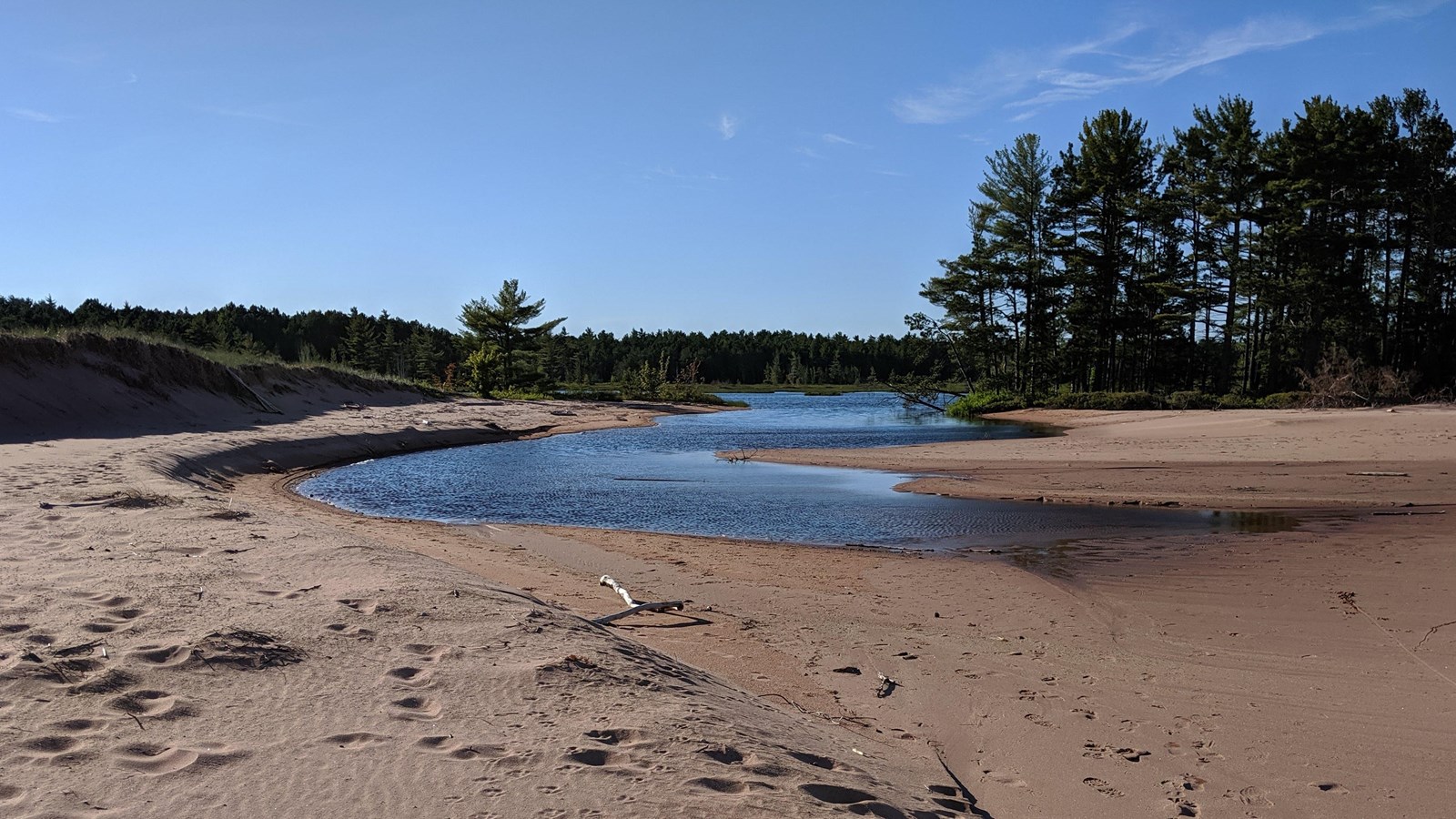Last updated: August 11, 2023
Place
Stockton Island

NPS photo/M. Carlson
Accessible Sites, Amphitheater, Animal-Safe Food Storage, Beach/Water Access, Boat Ramp, Canoe/Kayak/Small Boat Launch, Dock/Pier, Fire Pit, First Aid Kit Available, Historical/Interpretive Information/Exhibits, Information, Information - Ranger/Staff Member Present, Information Kiosk/Bulletin Board, Picnic Table, Toilet - Vault/Composting, Wheelchair Accessible
Wiisaakodewan-minis (Stockton Island) features sand beaches at Quarry Bay, Presque Isle Bay, and Julian Bay. What would the Apostle Islands be without sand? No island is blessed with more spectacular and diverse sandy areas than the 10,054 acre island. The bridge of sand connecting Presque Isle Point to the rest of Stockton Island is an outstanding example of a geologic feature called a “tombolo”. The tombolo is home to a variety of plant communities (bogs, dunes, lagoons, savannahs, and pine forests), the park’s largest campgound, and the “singing sands” of Julian Bay. People everywhere feel the call of the beach, but at Julian Bay, the call of the “singing” sand can actually be heard.
Leave No Trace Outdoor Ethics
Visitors can do their part to help protect park resources by following the seven principles of “Leave No Trace” outdoor ethics.
Boating and Camping
Docks are located at Presque Isle Bay and at Quarry Bay. Docking is available on a first-come first-served basis. Please observe all docking signs and regulations. A fee is charged for overnight docking. Some dock space is reserved for excursion and National Park Service boats. Boats can be anchored or beached in Quarry, Presque Isle, and Julian Bays. Boaters should monitor marine weather forecasts, since shifting wind conditions and subsequent rough water can pose a significant threat.
A half-mile long waterfront campground is located among the pines on Presque Isle Bay. Campsite #1 near the Presque Isle docks is accessible to visitors with mobility impairments. Two accessible group campsites are located at Quarry Bay. One individual campsite is located at Quarry Bay and another at Trout Point. Limited camping is also available outside of designated campsites. Camping permits are required for all camping in the national lakeshore. A camping fee is charged. Permits must be picked up at the Bayfield headquarters visitor center before the start of a trip.
Hiking
There are about 14 miles of hiking trails on the island. Portions of the Trout Point and Quarry Bay trails may be hard to follow. Off-trail travel can be strenuous. Rock ledges near the lake are slippery. Use caution when walking on them.
Bears
Stockton Island supports a resident population of black bears. A study of Stockton Island bears revealed that the population grew from two animals in 1984 to a high of 31 non-cub bears in 1994. DNA analysis of bear hair samples collected in 2002 determined that there were at least 26 different bears living on Stockton Island that summer. A similar study in 2010 identified only 13 bears on the island. Stockton’s resources can only support so many bears. When the population exploded, the animals naturally regulated their numbers. Some bears swam to other islands, females had fewer and smaller litters, and several smaller bears were killed and eaten.
Bears occasionally turn to alternative food sources. In summer 2002, a large boar with a scar on his rear end roamed between the camping areas at Presque Isle and Quarry Bay. “Skar’s” campground visits in search of “easy pickings” slowly became more frequent and menacing. After using every available nonlethal tool to discourage Skar’s aggressive behavior, park rangers were forced to shoot him. Visitors must take precautions to help keep this from happening again. Never approach or feed a bear. Keep a distance of at least 50 yards, even for photography.
Footprints
The natural and undisturbed areas of of the tombolo, Presque Isle, and Julian Bay never cease to amaze, while human history and its imprint are clearly visible at Quarry Bay. The island is a gem and a perfect stop for anyone looking to understand the overall significance and value of the Apostle Islands National Lakeshore.
Stockton Island has attracted people for centuries. Archeological evidence indicates that native populations may have fished on the island as much as 5,000 years ago. Over the past 1,000 years native people camped on the island seasonally to hunt, fish, gather berries, and harvest maple sap. By the late 1800s, Stockton Island attracted commercial activities such as fishing camps, lumber camps, and a brownstone quarry to its shores. Today, visitors flock to Stockton Island to anchor in its protected bays, explore its varied landscapes, camp in its lakeside campsites, and walk its white sand beaches.
The shoreline areas that attract the most visitors also tend to be very fragile. Vegetation in sandy areas is susceptible to trampling. When plants that stabilize the sand are killed, erosion becomes a problem. Informal trails mar the landscape around the Presque Isle campground and at Julian Bay. Visitors can help protect our fragile sandscapes by using sand ladders provided at the campsites, walking on designated trails and boardwalks, and on beaches below the line of vegetation. This will help leave no trace of our passing...except tracks on the beach.
